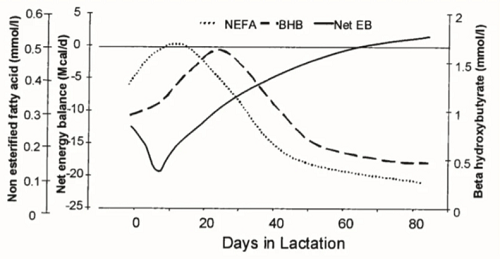Introduction
Nutrition has an important effect on reproductive potential of all living species. Body condition is a useful indicator of nutritional status and when used in conjunction with body weight change can provide a useful method to assess reproductive potential. Energy and protein are the nutrients required in the greatest amounts and should be first priority in developing nutritional programs to optimize reproduction. Minerals and vitamins must be balanced in the diet to optimize reproductive performance. Nutritional considerations and impacts on reproduction have primarily focused on postnatal development; however, prenatal nutrition appears to have potential effects on subsequent reproductive performance in dairy animals. Decline in fertility- changes in nutrition, housing, and herd management and interactions of these environmental changes with genetics.
Critical stage in the reproductive cycle
Transition period is the period from 3 weeks prepartum to 3 weeks postpartum is the most critical period. It is the Shift from gestational non lactating state to lactating state. In this phase dairy animals are more susceptible to metabolic and infectious disease; it is mainly because of the change in nutrient requirement that occur at the time of calving. Due to nutrient imbalance there may be mobilization of nutrients from the tissues. Mobilization of nutrients from body reserve during metabolic disorders like metabolic disorders as hypocalcaemia, acidosis, ketosis, fatty liver and displaced abomasums also have major consequences in the health of the animal, predisposes the animal to various reproductive disorder. Metabolic disorders and consequence may results in reproductive failure for example milk fever and ketosis affects uterine contractions, delays calving and increases the risk of retained foetal membranes (RFM) and endometritis.
Major nutrients and their effect on reproduction and fertility
Energy and protein
Excessive dietary nutrients during the last trimester of pregnancy may negatively influence calf birth weights and dystocia. Feeding excessive amounts of energy or protein before or after calving is not only costly, but animals with BCS >6 have lower reproductive performance and more calving difficulty than animals in moderate BCS 4-5. Excessive protein and energy both can have negative effects on reproduction. Overfeeding protein during the breeding season and early gestation, particularly if the rumen receives an inadequate supply of energy may be associated with decreased fertility. This decrease in fertility may result from decreased uterine pH during the luteal phase of the estrous cycle in cattle fed high levels of degradable protein. The combination of high levels of degradable protein and low energy concentrations in early-season grasses may contribute to lower fertility rates in females placed on such pastures near the time of breeding. Negative effects of excess rumen degradable intake protein on reproduction are well documented in dairy literature.
During early postpartum, high-producing dairy cows undergo a period of extensive tissue catabolism because of negative nutrient balance. Homeorhetic controls assure that nutrients are partitioned to favour lactation at the same time that homeostasis secures survival. Increased nutrient needs associated with suppression in appetite leads to negative energy balance. Commonly observed in last week of gestation and in first two months postpartum. High producing dairy cows’ experiences NEB during the first 4 to 6 weeks postpartum, which often averages -5 Mcal NEL/day, the equivalent of approximately 1 kg of body weight loss/day, mostly from adipose tissue. Reduced circulating concentrations of glucose and insulin upregulate the lipolytic signals that result in hydrolysis of stored triglycerides from the adipose tissue and increase the availability of NEFA to be used as an energy source. severe negative energy balance (NEB) based on excessive plasma non-esterified fatty acids (NEFA)), or both, affected cows had increased anovulation, reduced pregnancy per AI, and increased pregnancy loss. Maintaining metabolic health to minimize the risk of clinical and subclinical health problems are expected to benefit fertility of dairy cows.
Circulating concentration of NEFA can be used as an indicator to assess the energetic status of grazing dairy cows. The rate of pregnancy in the first 70 days of breeding was 16% less for cows with blood NEFA >0.7 mM than for those with concentrations below this threshold in early lactation. Ketosis has also been associated with compromised fertility. Both the relative circulating concentration of β-OH-butyrate (BHBA) and the duration of elevated BHBA concentrations were associated negatively with the probability of pregnancy following the first postpartum AI. In fact, for every 100 μM increase in BHBA on centration in weeks 1 and 2 after calving, the proportion of pregnant cows at first AI was reduced by 2 and 3%, respectively. Furthermore, the rate of pregnancy within 70 days after the end of the voluntary waiting period was 13% less among cows with blood BHBA concentration ≥ ~1.0 mM compared with herd mates with BHBA <1.0 mM. Furthermore, as the prevalence of cows with elevated concentrations of serum NEFA or BHBA increases, reproductive performance declines. Therefore, circulating concentrations of these metabolites can be used as indicators of excessive lipid mobilization that interfere with fertility. The reduction in fertility associated with low nutrient intake and NEB (relationship shown in fig. below) is, at least in part, mediated by the damaging effects on immunity and postpartum health.

Body condition score
BCS is the tool to measure the status of energy balance in the cow. The severity and length of NEB can be estimated through changes in body condition score (BCS). BCS (<2.5) – have a prolonged anoestrous period due to low LH pulse and concentrations of oestradiol, which are ineffective to induce an LH surge. High BCS (>3.5) which results in a subsequent prolonged period of negative energy balance (NEB) and low reproductive efficiency. Precondition the cow to moderate changes in NEB and minimal BCS loss (<0.5 unit) to overcome massive changes in metabolites and metabolic hormones during early postpartum period is very essential. Feeding high roughage diets at the start of the dry period to minimize BCS gain and maintaining change in BCS score of 0.5 during the transition period are important for high conception rates and herd pregnancy rates. To achieve this important target, cows should be maintained at a BCS of 2.5–3.0 in association with maintenance of proper rumen function through adequate dietary fibre, shortening the dry period (6–8 weeks maximum), reduction in the incidence of subclinical metabolic disorders, particularly hypocalcemia and minimizing mobilization of body reserves in the early postpartum period.
| Nutrient Consumption | Reproductive Consequence |
| Excessive energy intake | Low conception, abortion, dystocia, retained placenta, reduced libido |
| Inadequate energy intake | Delayed puberty, suppressed estrus and ovulation, suppressed libido and spermatozoa production |
| Excessive protein intake | Low conception rate |
| Inadequate protein intake | Suppressed estrus, low conception, fetal reabsorption, premature parturition, weak offspring |
Fat
Fatty acids and cholesterol are substrates for hormone synthesis, increasing fat in the diet may increase levels of reproductive hormones (progesterone, prostaglandins) or fats may act directly on the reproductive axis. Effects of fat may be independent of or additive to those of increased energy availability. Supplementing fat to improve reproduction was initially attempted to increase the energy density in the diet. High fat diets for cattle contain 5% to 8 % fat. Exceeding these dietary fat levels impairs rumen function. Lactating cows are the primary animals to be supplemented because of their increased energy requirements. indicated that feeding high fat diets to cycling heifers and postpartum cows increased progesterone production and the lifespan of the corpus luteum (CL). Higher progesterone levels during the luteal phase generally result in improved fertility. Increasing dietary fat also results in increased follicular growth. These changes in follicular growth and hormone production may enhance reproduction. Prepartum supplementation with Ca salts of long chain FA rich in omega 3 FA reduced the incidence of retained placenta, metritis and mastitis compared with cows not fed fat prepartum. Altering the FA supply to dairy cows not only alters the FA composition of uterine tissues, but has also the potential to influence immune function conception rates.
Vitamins
Major vitamins essential for proper reproductive behaviour are Vitamin A, D and E.
Deficiency of Vitamin E
- Depression in ovulation rate, uterine motility, sperm motility, conception rate, fetal membrane expulsion, embryo survival. Vitamin E+ Se injections during perpartum period can reduce the incidence of RFM from 17.5 to 0% and reduced metritis for about 40% in the risk group when compared to the control.
Deficiency of Vitamin A
- Late maturity
- Late conception
- Abortion
- Foetal deformities
- Retained placenta
- Uterine infection
- Delayed uterine involution
- Reduction in libido
- Increased incidence of cystic ovaries
Deficiency of Vitamin D
- Decreased absorption of calcium and phosphorus
- Silent heat or anoestrous
Minerals
Calcium
Calcium is the most essential mineral for optimum reproductive activity. All cows undergo a period of subclinical hypocalcaemia and a portion of them develop milk fever Cows from 1st to 6th lactation exhibited hypocalcaemia 25, 41, 49, 51, 54 and 42% respectively (less than 8mg/dl) in the first 48 h after calving. Cows with serum Ca <8.59 mg/dl in at least one of the first 3 days postpartum had reduced neutrophil phagocytic and killing activities in vitro, increased odds of developing fever and metritis. Chances for those cows to develop metritis because of low serum Ca was 75.3%. Ionized calcium as secondary intracellular messenger it is important to activate immune cells in case of Calcium deficiency failure of activation of immune cells may occur which predisposes to uterine pathology.
| Deficiency | Excess |
| Phosphorus
Important for normal sexual behavior Delayed puberty, silent or irregular estrus in heifers, still birth, embryonic death due to uterine atony |
Renders the endometrium susceptible for infection |
| Sodium and potassium
Affects the musculature of female genital tract causing impairment in the normal reproductive process. |
Lower fertility was noticed in cows fed high levels of potassium or diets in which potassium-sodium ratio was wide. |
| Molybdenum
Decreased libido, spermatogenesis and sterility in males and delayed puberty, reduced conception rate and anestrus in females. |
|
| Iodine
Delay in puberty, failure of fertilization, early embryonic death, still birth, abortion, increased frequency of deterioration of semen quality in males. Inadequate thyroid function reduces conception rate and ovarian activity. |
Abortion and decreased resistance to infection and disease.
|
| Manganese
Responsible for silent estrus and anestrus or irregular estrus and decrease conception rate, birth of deformed claves and abortions in females and absences of libido and improper or failure of spermatogenesis in males. |
|
| Selenium
Prone for the incidence of retained placenta, cystic ovaries, mastitis and metritis |
Causes abortion and early embryonic death
|
Copper
Deficiency – early embryonic death and resorption of the embryo, increased chances of retained placenta and necrosis of placenta and low fertility associated with delayed or depressed estrus.
Manganese
Important in cholesterol synthesis which in turn is necessary for the synthesis of steroids like progesterone, estrogen and testosterone.
Zinc
Essential for proper sexual maturity (development of secondary sexual characteristics), reproductive capacity in males and more specifically with onset of estrus in female. Has critical role in repair and maintenance of uterine lining following parturition.
Chromium
Potentiate insulin thereby improves the energy balance which in early lactation leads to improved reproduction. Moreover, chromium also exerts a significance influence on follicular maturation and luteinizing hormone release.
Nutritional imbalance affecting hormones essential for reproduction
Poor nutrition during the dry and early postpartum periods results in reduced glucose, insulin, insulin-like growth factor (IGF-I) and low LH pulse frequency. High nutrition can also increase metabolic clearance rate of steroid hormones such as progesterone or oestradiol. Lower concentrations of oestradiol on the day of oestrus are highly correlated with the occurrence of subestrus, thereby making the detection of oestrus in high yielding cows even more difficult. Nutrition also affects conception rate to AI. Excessive loss of BCS and excess protein content of the ration can reduce conception while supplemental fats that attenuate the production of PGF2α can improve conception rate. The increased metabolic clearance rate of progesterone, which decreases blood concentrations during early embryo cleavage up to the blastocyst stage is associated with decreased conception rates. The underlying mechanism for resumption of ovulatory cycles seems to be associated with metabolic signals and regulatory hormones primarily insulin and insulin like growth factor (IGF)-1, which link nutritional status with gonadotropin secretion, recoupling of the growth hormone-IGF system, and follicle maturation and ovulation. Feeding diets that promote increases in plasma glucose and insulin may improve the metabolic and endocrine status of cows in early lactation. Important indicator of nutritional status on the hypothalamic-pituitary-ovarian axis in the early postpartum period. Maintenance of dominant follicle preventing atresia.
Conclusion
Consequences of impaired or deficient nutrients to livestock can be severe to the farmer. In dairy industry animals are kept solely to produce milk and rear calves. If cow fails to conceive, her output will be zero and the farmer suffers financial loss. Small litters in sheep and pigs can be the critical factor between profit and loss. Hence great care must be given to nutrition in farm animals to ensure optimal reproduction and profitability in livestock.






Be the first to comment